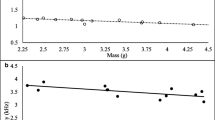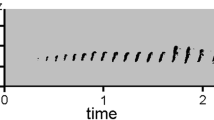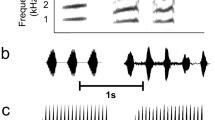Abstract
Acoustic duets—in which the female reveals herself to the advertising male—are a common means of establishing a temporary, pre-mating pair bond within Phaneropterinae katydids. Such duets, however, are especially susceptible to eavesdropping males that orient to signaling females and interrupt the established duet. It would therefore be advantageous for an advertising male to protect his investment in a duet from eavesdroppers. Male Scudderia pistillata katydids produce acoustic advertisement calls after which a conspecific female enters the duet by responding during a specific time-window with her own call, one or more acoustic ticks. We demonstrate here that when a duet is occurring in the presence of other calling males, the focal male produces a single acoustic tick that has a spectrum similar to that of the female’s tick and occurs during the time-window in which the female would respond to his advertisement call within the duet. The male acoustic tick may confound eavesdropping males if they have difficulty performing accurate phonotaxis to a female sound source when sounds arrive from two locations. We tested this hypothesis in laboratory arenas and determined that silent males eavesdrop on advertising male’s duets and accurately locate his female. Moreover, we found that the added acoustic tick produced by advertising males serves to mimic the female response and reduces the accuracy of eavesdropping males to localize the female. Therefore, male ticks appear to act as a form of pre-copulatory acoustic mate guarding of the calling male’s temporary pair bond with the female.




Similar content being viewed by others
References
Bailey WJ (2003) Insect duets: underlying mechanism and their evolution. Physiol Entomol 28:57–174. doi:10.1046/j.1365-3032.2003.00337.x
Bailey WJ, Field G (2000) Acoustic satellite behavior in the Australian bushcricket Elephantodeta nobilis (Phaneropterinae, Tettigoniidae, Orthoptera). Anim Behav 59:361–369. doi:10.1006/anbe.1999.1325
Bailey WJ, Macleay C, Gordon T (2006) Acoustic mimicry and disruptive alternative calling tactics in an Australian bushcricket (Caedicia; Phaneropterinae; Tettigoniidae; Orthoptera): Does mating influence male calling tactics? Physiol Entomol 31:201–210. doi:10.1111/j.1365-3032.2006.00501.x
Castellano S, Marconi V, Zanollo V (2009) Berto G (2009) Alternative mating tactics in the Italian treefrog, Hyla intermedia. Behav Ecol Sociobiol 63:1109–1118. doi:10.1007/s00265-009-0756-z
Cooley JR, Marshall DC (2001) Sexual signaling in periodical cicadas, Magicicada spp. (Hemiptera: Cicadidae). Behaviour 138:827–855. doi:10.1163/156853901753172674
Donelson NC, van Staaden MJ (2005) Alternate tactics in male bladder grasshoppers Bullacris membracioides (Orthoptera: Pneumoridae). Behaviour 142:761–778. doi:10.1163/1568539054729088
Gerhardt HC, Huber F (2002) Acoustic communication in insects and anurans: Common problems and diverse solutions. Chicago University Press, Chicago
Greenfield MD (2002) Signalers and receivers: mechanism and evolution of arthropod communication. Oxford University Press, Oxford
Gross MR (1996) Alternative reproductive strategies and tactics: diversity within sexes. TREE 11:92–98. doi:10.1016/0169-5347(96)81050-0
Gwynne DT (2001) Katydids and bush-crickets: reproductive behavior and evolution of the Tettigoniidae. Cornell University Press, Ithaca
Hammond TJ, Bailey WJ (2003) Eavesdropping and defensive auditory masking in an Australian bushcricket, Caedicia (Phaneropterinae: Tettigoniidae: Orthoptera). Behaviour 140:79–95. doi:10.1163/156853903763999917
Heller KG, van Helversen D (1986) Acoustic communication in phaneropterid bushcrickets: species-specific delay of female stridulatory response and matching male sensory time-window. Behav Ecol Sociobiol 18:189–198. doi:10.1007/BF00290822
Korsunovskaya OS (2008) Acoustic signals in katydids (Orthoptera, Tettigoniidae) communication I. Entomol Rev 38:1032–1050. doi:10.1134/S0013873808090029
Lewis SM, Cratsley CK (2008) Flash signal evolution, mate choice, and predation in fireflies. Annu Rev Entomol 53:293–321. doi:10.1146/annurev.ento.53.103106.093346
Lloyd JE (1979) Sexual selection in luminescent beetles. In: Blum M, Blum N (eds) Sexual selection and reproductive competition in insects. Academic Press, New York, pp 293–342
Nickle DA, Carlysle TC (1975) Morphology and function of female sound-producing structures in ensiferan Orthoptera with special emphasis on the Phaneropterinae. Int J Insect Morphol Embryol 4:159–168. doi:10.1016/0020-7322(75)90014-8
Otte D (1972) Simple versus elaborate behavior in grasshoppers: an analysis of communication in the genus Syrbula. Behaviour 42:291–322. doi:10.1163/156853972X00329
Papi F (1969) Light emission, sex attraction and male flash dialogues in a firefly, Luciola lusitanica (Charp.). Monitore Zool Ital 3:135–184
Reichard M, Comber SCL, Smith C (2007) Sneaking from a female perspective. Anim Behav 74:679–688. doi:10.1016/j.anbehav.2007.03.005
Rivers TJ, Morin JG (2009) Plasticity of male mating behaviour in a marine bioluminescent ostracodin both time and space. Anim Behav 78:723–734
Spooner JD (1964) The Texas bush katydid—its sounds and their significance. Anim Behav 12:235–244. doi:10.1016/0003-3472(64)90007-7
Spooner JD (1968a) Pair-forming acoustic systems of phaneropterine katydids (Orthoptera, Tettigoniidae). Anim Behav 16:197–212. doi:10.1016/0003-3472(68)90001-8
Spooner JD (1968b) Collection of male phaneropterine katydids by imitating sounds of the female. J Georgia Entomol Soc 3:45–46. doi:10.1016/0003-3472(68)90001-8
Stumpner A, Meyer S (2001) Songs and the function of song elements in four duetting bushcricket species (Ensifera, Phaneropteridae, Barbitistes). J Insect Behav 14:511–534. doi:10.1023/A:1011176106943
van Helversen D, Schul J, Kleindienst HU (2001) Male recognition mechanism for female responses implies a dilemma for their localization in a phaneropterinae bushcricket. J Comp Physiol A 186:1153–1158. doi:10.1007/s003590000167
Villarreal SM (2013) Acoustic communication in the duetting katydid, Scudderia pistillata (Orthoptera: Tettigoniidae: Phaneropterinae). Dissertation, Cornell University
Villarreal SM, Gilbert C (2011) Unique counting call of a katydid, Scudderia pistillata (Orthoptera: Tettigoniidae: Phaneropterinae). Ann Entomol Soc Am 104:945–951. doi:10.1603/AN11047
Villarreal SM, Gilbert C (2013) Female acoustic reply to variation in the male call in a duetting katydid, Scudderia pistillata. Behaviour 150:525–546
Woods WA Jr, Hendrickson H, Mason J, Lewis SM (2007) Energy and predation costs of firefly courtship signals. Am Nat 170:702–708. doi:10.1086/521964
Zar JH (1996) Biostatisticalanalysis, 3rd edn. Prentice Hall, New Jersey
Acknowledgments
We thank Jack Bradbury and Ron Hoy for invaluable advice and review of previous drafts of the manuscript, as well as the anonymous reviewers for their useful comments on this manuscript. This work was funded by the SUNY Diversity Fellowship, Sigma-Xi Grant-in-Aid of Research, and Cornell Entomology’s Grace Griswold Endowment and Rawlins Endowment Funds.
Author information
Authors and Affiliations
Corresponding author
Additional information
Communicated by D. Gwynne
Electronic supplementary material
Below is the link to the electronic supplementary material.
ESM 1
(WAV 391 kb)
Rights and permissions
About this article
Cite this article
Villarreal, S.M., Gilbert, C. Male Scudderia pistillata katydids defend their acoustic duet against eavesdroppers. Behav Ecol Sociobiol 68, 1669–1675 (2014). https://doi.org/10.1007/s00265-014-1775-y
Received:
Revised:
Accepted:
Published:
Issue Date:
DOI: https://doi.org/10.1007/s00265-014-1775-y




